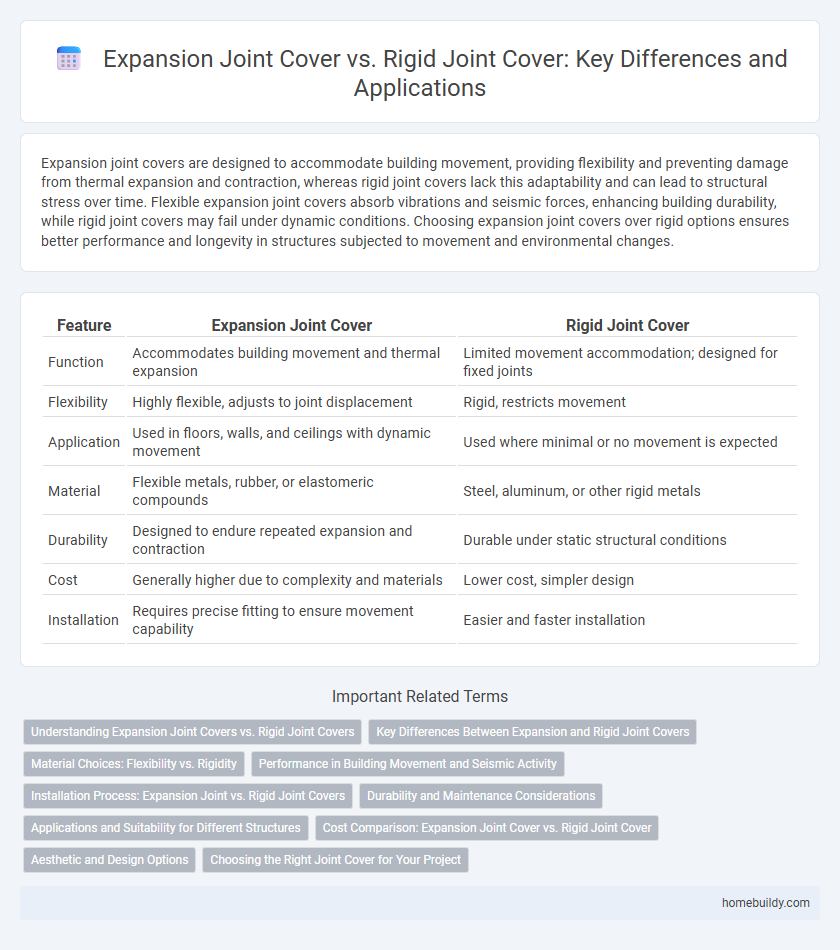Expansion joint covers are designed to accommodate building movement, providing flexibility and preventing damage from thermal expansion and contraction, whereas rigid joint covers lack this adaptability and can lead to structural stress over time. Flexible expansion joint covers absorb vibrations and seismic forces, enhancing building durability, while rigid joint covers may fail under dynamic conditions. Choosing expansion joint covers over rigid options ensures better performance and longevity in structures subjected to movement and environmental changes.
Table of Comparison
| Feature | Expansion Joint Cover | Rigid Joint Cover |
|---|---|---|
| Function | Accommodates building movement and thermal expansion | Limited movement accommodation; designed for fixed joints |
| Flexibility | Highly flexible, adjusts to joint displacement | Rigid, restricts movement |
| Application | Used in floors, walls, and ceilings with dynamic movement | Used where minimal or no movement is expected |
| Material | Flexible metals, rubber, or elastomeric compounds | Steel, aluminum, or other rigid metals |
| Durability | Designed to endure repeated expansion and contraction | Durable under static structural conditions |
| Cost | Generally higher due to complexity and materials | Lower cost, simpler design |
| Installation | Requires precise fitting to ensure movement capability | Easier and faster installation |
Understanding Expansion Joint Covers vs. Rigid Joint Covers
Expansion joint covers provide flexibility and allow for building movement caused by thermal expansion, seismic activity, or structural shifts, protecting the integrity of surfaces by accommodating these motions. In contrast, rigid joint covers offer limited movement, making them suitable for areas with minimal expansion and contraction, but they may risk damage or cracking in dynamic environments. Selecting between expansion joint covers and rigid joint covers depends on the specific building requirements, expected movement range, and environmental conditions to ensure structural durability and safety.
Key Differences Between Expansion and Rigid Joint Covers
Expansion joint covers accommodate building movement through flexible materials and allow for thermal expansion, contraction, and seismic activity, ensuring structural integrity. Rigid joint covers, in contrast, provide a solid, fixed connection that limits movement and are typically used in applications where movement is minimal or needs to be restricted. The key differences lie in flexibility, movement accommodation, and suited application environments, with expansion joint covers offering durability in dynamic conditions and rigid joint covers suited for static structural elements.
Material Choices: Flexibility vs. Rigidity
Expansion joint covers are typically made from flexible materials like neoprene or rubber, allowing them to accommodate building movements and thermal expansion effectively. In contrast, rigid joint covers use metal or hard polymer components that provide structural stability but offer limited flexibility. The choice between flexible and rigid materials depends on the specific application requirements, such as expected movement range and load-bearing capacity.
Performance in Building Movement and Seismic Activity
Expansion joint covers provide superior flexibility compared to rigid joint covers, allowing buildings to accommodate thermal expansion, contraction, and seismic movements without damage. They absorb and distribute stresses during seismic events effectively, reducing structural strain and potential cracking. Rigid joint covers, lacking this adaptability, are prone to failure under dynamic building movements, compromising overall building integrity.
Installation Process: Expansion Joint vs. Rigid Joint Covers
Expansion joint cover installation requires accommodation for structural movement, involving flexible materials and adjustable anchoring systems to ensure continuous protection against joint stress and building vibrations. In contrast, rigid joint cover installation involves fixed materials that necessitate precise alignment and secure attachment to maintain stability without allowing for movement. The complexity of expansion joint cover installation typically demands specialized techniques to accommodate thermal expansion and contraction, whereas rigid joint covers focus on maintaining a consistent joint gap with minimal flexibility.
Durability and Maintenance Considerations
Expansion joint covers provide superior durability by accommodating building movements and thermal expansion, reducing stress and preventing structural damage compared to rigid joint covers. Maintenance requirements are lower for expansion joint covers as their flexibility minimizes wear and tear, whereas rigid joint covers are prone to cracking and require frequent repairs. Selecting expansion joint covers enhances long-term performance and lowers lifecycle maintenance costs in dynamic building environments.
Applications and Suitability for Different Structures
Expansion joint covers are ideal for structures with significant movement due to thermal expansion, seismic activity, or vibrations, including bridges, parking garages, and high-rise buildings. Rigid joint covers suit applications requiring minimal flexibility and are commonly used in industrial floors and warehouses with controlled environmental conditions. The choice depends on the structure's movement demands and load-bearing requirements, ensuring durability and functionality.
Cost Comparison: Expansion Joint Cover vs. Rigid Joint Cover
Expansion joint covers typically cost more upfront than rigid joint covers due to their flexible materials and complex installation requirements. However, they offer superior durability and reduced maintenance costs over time by accommodating building movement and preventing damage. Rigid joint covers, while less expensive initially, may incur higher long-term repair expenses due to their inability to absorb structural shifts effectively.
Aesthetic and Design Options
Expansion joint covers offer superior aesthetic and design versatility compared to rigid joint covers, allowing seamless integration with various architectural styles and surface materials. Their flexible materials and customizable profiles accommodate movements without compromising visual appeal, supporting sleek lines and textured finishes that rigid covers often lack. This adaptability makes expansion joint covers ideal for modern designs seeking both functionality and refined aesthetics.
Choosing the Right Joint Cover for Your Project
Expansion joint covers accommodate building movement and thermal expansion, reducing structural stress and preventing damage, while rigid joint covers offer fixed protection but lack flexibility. Selecting the right joint cover depends on factors such as expected movement range, environmental conditions, and load requirements, with expansion joint covers ideal for areas subject to frequent shifting or seismic activity. Prioritizing movement accommodation and durability ensures longevity and safety in construction projects.
expansion joint cover vs rigid joint cover Infographic

 homebuildy.com
homebuildy.com